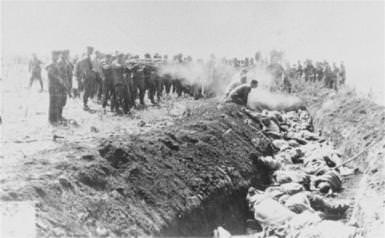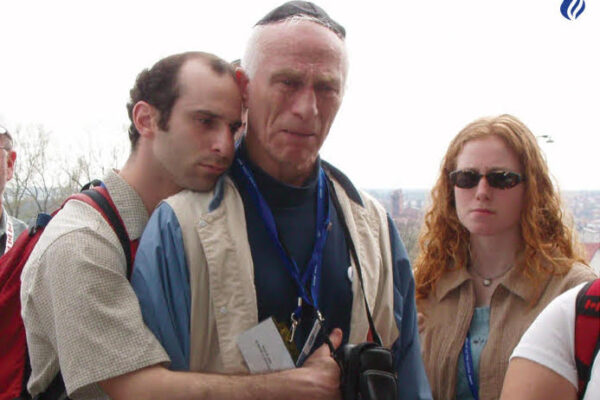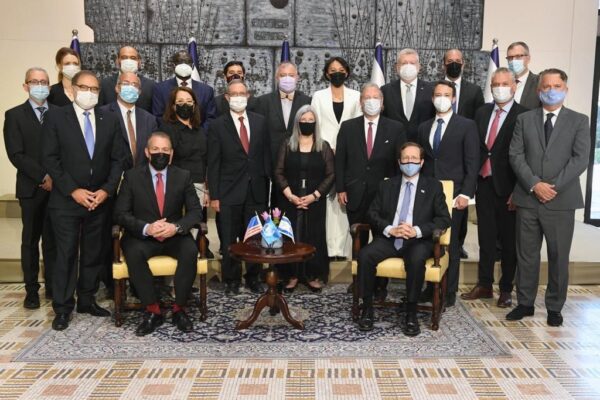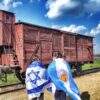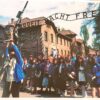
Men with an unidentified unit execute a group of Soviet civilians kneeling by the side of a mass grave. (June 22, 1941 – September 1, 1941). (Photo courtesy National Archives and Records Administration, College Park)
During the Holocaust, mobile killing squads known as Einsatzgruppen (made up of groups of German soldiers and local collaborators) killed over one million people following the invasion of the Soviet Union.
From June 1941 until their operations were curtailed in the spring of 1943, Einsatzgruppen conducted mass killings of Jews, Communists, and the disabled in Nazi-occupied areas in the East. The Einsatzgruppen were the first step in the Nazi’s implementation of the Final Solution.
Origins of the Final Solution
In September 1919, Adolf Hitler first wrote down his ideas about “the Jewish Question,” comparing the presence of Jews to that of tuberculosis. To be certain, he wanted all Jews removed from German lands; however, at the time, he did not necessarily mean genocide.
After Hitler came to power in 1933, the Nazis attempted to remove Jews by making them so unwelcome that they would emigrate.
There were also plans to remove the Jews en masse by moving them to an island, perhaps to Madagascar. However unrealistic the Madagascar Plan was, it did not involve mass killing.
In July 1938, delegates from 32 countries met at the Evian Conference in Evian, France to discuss the increasing number of Jewish refugees fleeing Germany. With many of these countries having difficulty feeding and employing their own populations during the Great Depression, nearly every delegate stated that their country could not increase their refugee quota.
Without an option to send Jews elsewhere, the Nazis began to formulate a different plan to rid their lands of Jews – mass killing.
Historians now place the beginning of the Final Solution with the German invasion of the Soviet Union in 1941.
The initial strategy directed mobile killing squads, or Einsatzgruppen, to follow the Wehrmacht (Germany army) into the East and eliminate Jews and other undesirables from these newly claimed lands.
Organization of the Einsatzgruppen
There were four Einsatzgruppen divisions sent east, each with 500 to 1,000 trained Germans.
Many members of the Einsatzgruppen had once been part of the SD (Security Service) or the Sicherheitspolizei (Security Police), with about a hundred having been once part of the Kriminalpolizei (Criminal Police).
The Einsatzgruppen were tasked with eliminating Communist officials, Jews, and other “undesirables” such as Roma (Gypsies) and those that were mentally or physically ill.
With their goals clear, the four Einsatzgruppen followed the Wehrmacht east. Labeled Einsatzgruppe A, B, C, and D, the groups were focused on the following areas:
- Einsatzgruppe A: Baltic nations of Latvia, Lithuania and Estonia
- Einsatzgruppe B: Eastern Poland and Belorussia
- Einsatzgruppe C: Western Ukraine
- Einsatzgruppe D: Southern Ukraine and Crimea
In each of these areas, the 3,000 German members of the Einsatzgruppen units were aided by local police and civilians, who often willingly collaborated with them. Also, while the Einsatzgruppen were supplied by the Wehrmacht, oftentimes army units would be used to help guard victims and/or the gravesite before the massacre.
Einsatzguppen as Killers
Most massacres by the Einsatzgruppen followed a standard format. After an area was invaded and occupied by the Wehrmacht, members of the Einsatzgruppen and their local auxiliaries rounded up the local Jewish populations, Communist functionaries, and disabled individuals.
These victims were often held in a central location, such as a synagogue or town square, before being taken to a remote area outside of the town or village to be executed.
The execution sites were generally prepared in advance, either by the location of a natural pit, ravine, or old quarry or through the use of forced labor to dig out an area to serve as a mass grave. Individuals who were to be killed were then taken to this location on foot or by trucks supplied by the German military.
Once the individuals arrived at the mass grave, the executioners would force them to remove their clothing and valuables and then step up to the edge of the pit. Victims were shot by the members of the Einsatzgruppen or their auxiliaries, who typically adhered to a one bullet per person policy.
Since not every perpetrator was a polished killer, some victims did not die immediately and instead suffered a slow and painful death.
While the victims were being killed, other members of the Einsatzgruppen sorted through the victims’ personal belongings. These belongings would either be sent back to Germany as provisions for bombed-out civilians or they would be auctioned off to the local population and the funds would be utilized to fund further Einsatzgruppen actions and other German military needs.
At the conclusion of the massacre, the mass grave would be covered over with dirt. Over time, evidence of the massacres was often difficult to detect without the assistance of members of the local populations who either witnessed or aided in these events.
The Massacre at Babi Yar
The largest single-site massacre by an Einsatzgruppen unit took place outside of the Ukrainian capital of Kiev on September 29-30, 1941. It was here that the Einsatzgruppe C executed nearly 33,771 Jews in a mass ravine known as Babi Yar.
Following the shootings of Jewish victims in late September, other individuals in the local area who were deemed undesirables, such as Roma (Gypsies) and the disabled were also shot and dumped into the ravine. In total, an estimated 100,000 people are said to be buried at this site.
An Emotional Toll
Shooting defenseless people, especially large groups of women and children, can take a large emotional toll on even the most trained soldier. Within months of beginning the massacres, leaders of the Einsatzgruppen realized that there was a high emotional cost to shooting victims.
The extra liquor rations for members of the Einsatzgruppen was not enough. By August 1941, Nazi leaders were already searching for less personal ways of killing, which led to the invention of gas vans. Gas vans were trucks which had been specially outfitted for killing. Victims would be placed in the backs of the trucks and then exhaust fumes would be piped into the back.
Gas vans were a stepping stone to the invention of stationary gas chambers built specifically for killing Jews at death camps.
Covering Up Their Crimes
At first, the Nazis made no attempt to hide their crimes. They conducted the mass killings during the day, with full knowledge of the local populace. However, after a year of killing, the Nazis made a decision in June 1942 to start eradicating evidence.
This change of policy was partly because most of the mass graves had been hastily covered and were now proving to be a health risk and also because news of the atrocities had begun to leak out to the West.
A group known as Sonderkommando 1005, headed by Paul Blobel, was formed to eliminate the mass graves. Work began at the Chelmno Death Camp and then began in occupied areas of the Soviet Union in June 1943.
To eliminate the evidence, the Sonderkommandos had prisoners (mostly Jewish ones) dig up the mass graves, move the corpses to a pyre, burn the bodies, crush bones, and scatter the ashes. When an area was cleared, these Jewish prisoners were also killed.
While many mass graves were dug up, many more remained. The Nazis did, however, burn enough corpses to make it difficult to determine an accurate number of victims.
Post-War Trials of Einsatzgruppen
Following World War II, a series of trials were held by the United States in the German city of Nuremberg. The ninth of the Nuremberg Trials was The United States of America v. Otto Ohlendorf et al. (but is more commonly known as the “Einsatzgruppen Trial”), where 24 high-ranking officials within the ranks of the Einsatzgruppen were put on trial from July 3, 1947 to April 10, 1948.
The defendants were charged with one or more of the following crimes:
- Crimes Against Humanity
- War Crimes
- Membership in a criminal organization
Of the 24 defendants, 21 were found guilty on all three counts, while two were only convicted of “membership in a criminal organization” and one other was removed from the trial for health reasons prior to the sentencing (he died six months later).
The penalties varied ranging from death to a few years of imprisonment. In total, 14 individuals were sentenced to death, two received life in prison, and four received sentences ranging from time already served to 20 years. One individual committed suicide before he was sentenced.
Of those sentenced to death, only four were actually executed and many others ultimately had their sentences commuted.
Documenting the Massacres Today
Many of the mass graves remained hidden in the years following the Holocaust. Local populations were aware of their existence but did not frequently speak of their location.
Beginning in 2004, a Catholic priest, Father Patrick Desbois, began a formal effort to document the location of these mass graves. Although locations do not receive official markers for fear of looting, their locations are documented as part of the efforts of DuBois and his organization, Yahad-In Unum.
To date, they have discovered the locations of nearly 2,000 mass graves.

